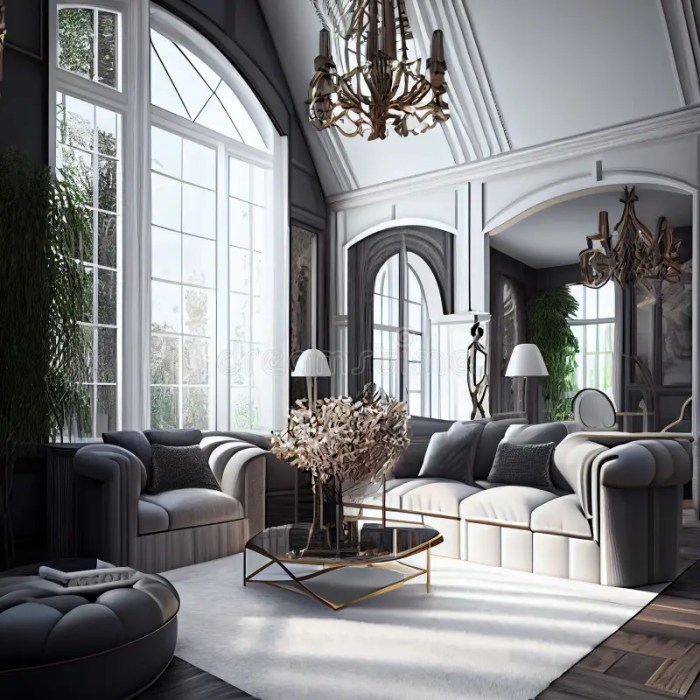Interior design for luxury homes is more than just aesthetics; it’s an art form that transforms living spaces into elegant, personalized havens. As luxury homeowners seek to express their unique styles while embracing comfort and sophistication, the role of skilled interior designers becomes paramount in achieving these high-end visions. From opulent materials to cutting-edge technology, the nuances of luxury home design set it apart from standard approaches, making it a fascinating area of exploration for both enthusiasts and professionals alike.
This journey into the realm of luxury interior design reveals the critical elements that define these spaces, such as signature styles from renowned designers, key architectural features, and the importance of modern technologies. By delving into current trends, sustainable practices, and innovative marketing strategies, we can appreciate the complexity and allure of designing luxury homes that not only meet but exceed the expectations of discerning clients.
Introduction to Interior Design for Luxury Homes
Luxury interior design plays a critical role in elevating residential properties, distinguishing them from standard designs. It encompasses the artistry and craftsmanship that go into creating personalized environments that reflect the wealth and tastes of their owners. In luxury homes, every detail matters, from the choice of furniture to the selection of materials and finishes.Elements that differentiate luxury home design from standard design include superior materials, bespoke furnishings, and intricate detailing.
Luxury interiors often feature high ceilings, spacious layouts, and sophisticated lighting that work together to create a sense of opulence. Renowned interior designers such as Kelly Wearstler, Philippe Starck, and Peter Marino are celebrated for their unique styles that seamlessly blend functionality with elegance, showcasing the best of luxury living.
Features of Luxury Mansion Design
Luxury mansions are defined by a variety of architectural features that convey grandeur and sophistication. Common characteristics include expansive floor plans, grand staircases, and outdoor living spaces designed for entertaining. These homes often incorporate elements like large windows and open layouts that enhance natural light and connectivity with the outdoors.The importance of materials and finishes cannot be overstated in luxury home design.
High-quality materials such as marble, hardwood, and custom cabinetry are essential in creating an atmosphere of luxury. Integrating modern technologies, such as smart home systems and energy-efficient appliances, further enhances the appeal of luxury spaces, providing convenience and sustainability.
The Role of Real Estate Agents in Luxury Home Sales
Real estate agents play a pivotal role in the marketing and sales of luxury homes. Effective marketing strategies often include staging, high-end photography, and virtual tours to showcase properties in their best light. Agents are also adept at targeting specific demographics, using their networks to connect with potential buyers.To excel in the luxury market, real estate agents must possess specific skills, including negotiation expertise, market knowledge, and a keen understanding of client needs.
Building relationships with high-net-worth clients requires a personalized approach and a deep understanding of luxury lifestyles, ensuring agents can cater to their clients’ unique preferences.
Luxury Home Staging Techniques
Home staging is a vital aspect of marketing luxury properties, as it showcases the home’s potential and enhances its appeal to buyers. Effective staging highlights the home’s best features while creating an inviting atmosphere. A well-staged luxury home can significantly impact buyer perception and drive higher offers.Essential staging elements for luxury homes include:
- High-quality furnishings and decor that reflect elegance.
- Strategic lighting to create warm and inviting spaces.
- Artwork and accessories that complement the style of the home.
- Landscaping that enhances curb appeal and outdoor living areas.
- Neutral color palettes that allow potential buyers to envision their own style.
Before-and-after staging case studies illustrate the transformative power of staging, often resulting in quicker sales and higher closing prices.
Trends in Luxury Interior Design
Current trends in luxury home interiors emphasize personalization and sustainability. Homeowners increasingly seek designs that reflect their individuality, incorporating unique elements that tell their stories. Additionally, there is a growing preference for sustainable practices that reduce environmental impact without compromising luxury.Comparing traditional versus contemporary styles reveals a shift towards modern minimalism in luxury homes. Clean lines, open spaces, and functional designs are becoming hallmarks of contemporary luxury, often paired with traditional elements for a balanced aesthetic.
Sustainable practices within luxury interior design include using eco-friendly materials, energy-efficient appliances, and designs that promote natural light and air circulation.
The Impact of Commercial Properties on Luxury Home Design
Commercial real estate developments significantly influence luxury residential areas, often driving up property values and enhancing the desirability of neighborhoods. Luxury homes benefit from proximity to upscale retail, dining, and entertainment options that cater to affluent lifestyles.The relationship between luxury homes and nearby commercial amenities is symbiotic; as luxury residential projects emerge, they attract high-end services and businesses, creating vibrant communities.
Examples of luxury residential projects integrated with commercial real estate include mixed-use developments that offer residents exclusive access to boutiques, gourmet restaurants, and leisure facilities.
Understanding Real Estate Investing in Luxury Markets
Investing in luxury real estate requires a strategic approach, focusing on high-value properties in desirable locations. Investors must conduct thorough market research to identify emerging trends and evaluate potential risks and rewards. Luxury home investments often yield significant returns, particularly in high-demand areas.The risks associated with luxury home investments can include market volatility and changes in buyer preferences. However, the rewards, such as appreciation in property value and rental income, can be substantial.
Compared to other types of real estate investing, luxury home investing offers unique opportunities and challenges, necessitating a well-informed strategy.
Building a Luxury Home: Considerations and Challenges

The luxury home building process involves several essential steps, including careful planning, site selection, and design development. Collaborating with experienced architects and interior designers is crucial to ensuring that the final product meets the homeowner’s vision and quality standards.Challenges faced when designing and constructing luxury homes can include budget constraints, obtaining permits, and coordinating with various contractors. Selecting the right builders and contractors is vital for the success of luxury projects, as their expertise directly impacts the quality and timeliness of construction.
Marketing Strategies for Luxury Real Estate
Effective marketing techniques for luxury properties encompass a range of strategies tailored to attract discerning buyers. High-quality visual content, including professional photography and video tours, is essential for showcasing luxury homes. Additionally, leveraging digital marketing platforms allows agents to reach a broader audience effectively.Digital marketing plays a crucial role in promoting luxury real estate, utilizing social media, targeted ads, and email campaigns to engage potential buyers.
Virtual tours have become increasingly popular, offering an immersive experience that allows clients to explore properties from the comfort of their homes, enhancing the appeal of luxury listings.
Green Real Estate in Luxury Home Design
Eco-friendly designs are gaining significance in luxury homes, reflecting a growing awareness of environmental issues among affluent buyers. Integrating sustainable practices not only benefits the planet but also enhances the overall appeal and marketability of luxury properties.Innovative green materials suitable for luxury house designs include recycled steel, bamboo flooring, and low-VOC paints. As the luxury market continues to evolve, the future of sustainable practices in luxury real estate is promising, with an increasing number of homeowners prioritizing eco-friendly features in their designs.
Final Summary
In conclusion, the world of interior design for luxury homes is a vibrant blend of creativity, innovation, and sophistication. As we navigate through the trends and techniques that shape these exquisite spaces, it becomes evident that each element contributes to a larger narrative of luxury living. Whether it’s through eco-friendly designs or the seamless integration of technology, the future of luxury home design promises to be as dynamic as the individuals who inhabit these carefully curated environments, inspiring us all to dream bigger in our own spaces.
Quick FAQs
What are the key elements of luxury interior design?
The key elements include high-quality materials, unique design features, personalized aesthetics, and innovative technologies that enhance comfort and functionality.
How can I find a good luxury interior designer?
Look for designers with a strong portfolio, client testimonials, and experience in high-end projects, and consider scheduling consultations to discuss your vision.
What is the importance of home staging in luxury markets?
Home staging enhances the visual appeal of luxury properties, helping potential buyers envision themselves in the space and increasing the chances of a sale.
Are sustainable practices common in luxury home design?
Yes, there is a growing trend towards integrating sustainable materials and eco-friendly designs in luxury homes, reflecting a commitment to both quality and environmental responsibility.
What trends are currently shaping luxury interior design?
Current trends include a focus on minimalism, the use of natural materials, biophilic design elements, and the incorporation of smart home technologies.
